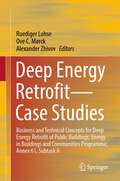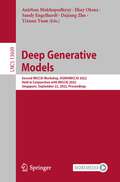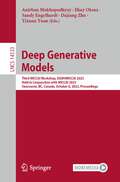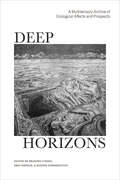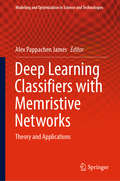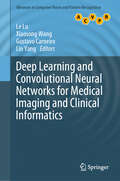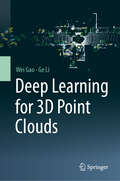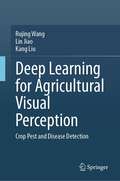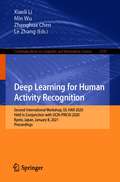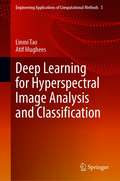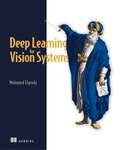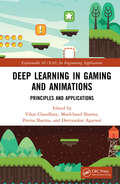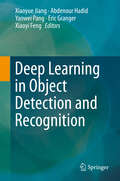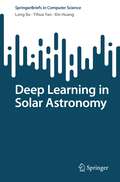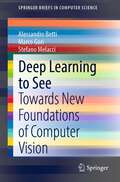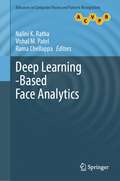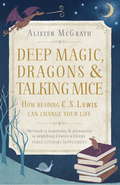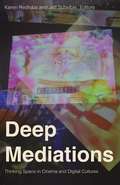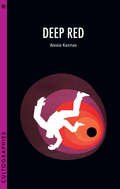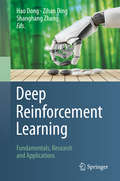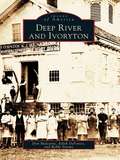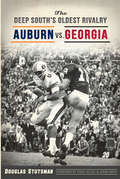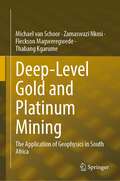- Table View
- List View
Deep Energy Retrofit—Case Studies: Business and Technical Concepts for Deep Energy Retrofit of Public Buildings; Energy in Buildings and Communities Programme; Annex 61, Subtask A
by Alexander Zhivov Ruediger Lohse Ove C. MørckThis book describes results of research conducted with the goal of providing a framework, selected tools, and guidelines to significantly reduce energy use (by more than 50%) in government and public buildings. The scope of the book is limited to public buildings that were constructed before the 1980s with low internal loads (e.g., office buildings, dormitories, barracks, public housing, and educational buildings) and that were undergoing major renovation. The book contains description and analysis of 26 well-documented case studies from Europe (Austria, Denmark, Estonia, Germany, Ireland, Latvia, Montenegro, The Netherlands, and the UK) and the USA. After these data were collected, the case studies were analyzed with respect to energy use (before and after renovation), reasons for undertaking the renovation, co-benefits achieved, resulting cost-effectiveness, and the business models followed. Finally, “lessons learned” were compiled and compared.Deep Energy Retrofit (DER) is a major building renovation project in which site energy use intensity (including plug loads) has been reduced by at least 50% from the pre-renovation baseline with a corresponding improvement in indoor environmental quality and comfort. Lessons learned from the case studies and experiences of the team clearly indicate that DER can be achieved with the application of “bundles” of a limited number of core technologies readily available on the market. Specific characteristics of some of these core technology bundles generally depend on the technologies available on an individual nation’s market, on the minimum requirements of national standards, and on economics (as determined by a life cycle cost [LCC] analysis).
Deep Generative Models: Second MICCAI Workshop, DGM4MICCAI 2022, Held in Conjunction with MICCAI 2022, Singapore, September 22, 2022, Proceedings (Lecture Notes in Computer Science #13609)
by Anirban Mukhopadhyay Dajiang Zhu Sandy Engelhardt Ilkay Oksuz Yixuan YuanThis book constitutes the refereed proceedings of the Second MICCAI Workshop on Deep Generative Models, DG4MICCAI 2022, held in conjunction with MICCAI 2022, in September 2022. The workshops took place in Singapore. DG4MICCAI 2022 accepted 12 papers from the 15 submissions received. The workshop focusses on recent algorithmic developments, new results, and promising future directions in Deep Generative Models. Deep generative models such as Generative Adversarial Network (GAN) and Variational Auto-Encoder (VAE) are currently receiving widespread attention from not only the computer vision and machine learning communities, but also in the MIC and CAI community.
Deep Generative Models: Third MICCAI Workshop, DGM4MICCAI 2023, Held in Conjunction with MICCAI 2023, Vancouver, BC, Canada, October 8, 2023, Proceedings (Lecture Notes in Computer Science #14533)
by Anirban Mukhopadhyay Dajiang Zhu Sandy Engelhardt Ilkay Oksuz Yixuan YuanThis LNCS conference volume constitutes the proceedings of the third MICCAI Workshop, DGM4MICCAI 2023, Held in Conjunction with MICCAI 2023, Vancouver, BC, Canada, October 2023. The 23 full papers included in this volume were carefully reviewed and selected from 38 submissions.The conference presents topics ranging from methodology, causal inference, latent interpretation, generative factor analysis to applications such as mammography, vessel imaging, and surgical Videos.
Deep Horizons: A Multisensory Archive of Ecological Affects and Prospects
by Brianne CohenThe specifics of ecological destruction often take a cruel turn, affecting those who can least resist its impacts and are least responsible for it. Deep Horizons: A Multisensory Archive of Ecological Affects and Prospects gathers contributions from multiple disciplines to investigate intersectional questions of how the changing planet affects specific peoples, communities, wildlife species, and ecosystems in varying and inequitable ways. A multisensory, artistic-archival supplement to the Mellon Sawyer Environmental Futures Project, the volume enriches current conversations bridging the environmental humanities and affect theory with insights from Native and Indigenous philosophies as well as by highlighting artistic practices that make legible the long-term durational effects of ecological catastrophe. Poems, nonfiction essays, sound-texts, photographs, and other artworks invite readers and viewers to consider the less visible losses and prospects of environmental transformation. Gathering contributions from multiple disciplines, this multimodal, multisensorial volume pushes the boundaries of scholarship with an experimental, born-digital format that offers a set of responses to collective traumas such as climate change, environmental destruction, and settler colonialism. The artists and authors honor the specificity of real historical and material injustices while also reflecting the eclectic nature of such assorted feelings, working through them in creative and border-crossing modes. With contributions from Robert Bailey, Nina Elder, Erin Espelie, Hock E Aye Vi Edgar Heap of Birds, Maya Livio, Erika Osborne, Craig Santos Perez, Kim Tallbear, Julianne Warren, and Kyle Powys White. "The compelling juxtaposition of poetry, music, video, audio, photography, printmaking, and traditional essays is among Deep Horizons' considerable strengths. I don’t know of any other project quite like this one. The subject is timely—indeed, urgent—and the innovative approach to archiving environmental change will interest scholars and artists in a range of disciplines and resonate with a wide audience." —Jennifer Ladino, University of Idaho
Deep Inside the Blues: Photographs and Interviews (American Made Music Series)
by Margo CooperDeep Inside the Blues collects thirty-four of Margo Cooper’s interviews with blues artists and is illustrated with over 160 of her photographs, many published here for the first time. For thirty years, Cooper has been documenting the lives of blues musicians, their families and homes, neighborhoods, festivals, and gigs. Her photographic work combines iconic late-career images of many legendary figures including Bo Diddley, Honeyboy Edwards, B. B. King, Pinetop Perkins, and Hubert Sumlin with youthful shots of Cedric Burnside, Shemekia Copeland, and Sharde Thomas, themselves now in their thirties and forties. During this time, the Burnside and Turner families and other Mississippi artists such as T-Model Ford, James “Super Chikan” Johnson, and L. C. Ulmer entered the national and international spotlight, ensuring the powerful connection between authentic Delta, Hill Country, and Piney Woods blues musicians and their audience continues. In 1993, Cooper began photographing in the clubs around New England, then in Chicago, and before long in Mississippi and Helena, Arkansas. On her very first trips to Mississippi in 1997 and 1998, Cooper had the good fortune to photograph Sam Carr, Frank Frost, Bobby Rush, and Otha Turner, among others. “The blues come out of the field,” Ulmer told Cooper. Seeing those fields, as well as the old juke joints, country churches, and people’s homes, inspired her. She began recording interviews with the musicians, sometimes over a period of years, listening and asking questions as their narratives unfolded. Many of the key blues players of the period have already passed, making their stories and Cooper’s photographs of them all the more poignant and valuable.
Deep Learning Classifiers with Memristive Networks: Theory and Applications (Modeling and Optimization in Science and Technologies #14)
by Alex Pappachen JamesThis book introduces readers to the fundamentals of deep neural network architectures, with a special emphasis on memristor circuits and systems. At first, the book offers an overview of neuro-memristive systems, including memristor devices, models, and theory, as well as an introduction to deep learning neural networks such as multi-layer networks, convolution neural networks, hierarchical temporal memory, and long short term memories, and deep neuro-fuzzy networks. It then focuses on the design of these neural networks using memristor crossbar architectures in detail. The book integrates the theory with various applications of neuro-memristive circuits and systems. It provides an introductory tutorial on a range of issues in the design, evaluation techniques, and implementations of different deep neural network architectures with memristors.
Deep Learning and Convolutional Neural Networks for Medical Imaging and Clinical Informatics (Advances in Computer Vision and Pattern Recognition)
by Gustavo Carneiro Le Lu Lin Yang Xiaosong WangThis book reviews the state of the art in deep learning approaches to high-performance robust disease detection, robust and accurate organ segmentation in medical image computing (radiological and pathological imaging modalities), and the construction and mining of large-scale radiology databases. It particularly focuses on the application of convolutional neural networks, and on recurrent neural networks like LSTM, using numerous practical examples to complement the theory. The book’s chief features are as follows: It highlights how deep neural networks can be used to address new questions and protocols, and to tackle current challenges in medical image computing; presents a comprehensive review of the latest research and literature; and describes a range of different methods that employ deep learning for object or landmark detection tasks in 2D and 3D medical imaging. In addition, the book examines a broad selection of techniques for semantic segmentation using deep learning principles in medical imaging; introduces a novel approach to text and image deep embedding for a large-scale chest x-ray image database; and discusses how deep learning relational graphs can be used to organize a sizable collection of radiology findings from real clinical practice, allowing semantic similarity-based retrieval.The intended reader of this edited book is a professional engineer, scientist or a graduate student who is able to comprehend general concepts of image processing, computer vision and medical image analysis. They can apply computer science and mathematical principles into problem solving practices. It may be necessary to have a certain level of familiarity with a number of more advanced subjects: image formation and enhancement, image understanding, visual recognition in medical applications, statistical learning, deep neural networks, structured prediction and image segmentation.
Deep Learning for 3D Point Clouds
by Wei Gao Ge LiAs an efficient 3D vision solution, point clouds have been widely applied into diverse engineering scenarios, including immersive media communication, autonomous driving, reverse engineering, robots, topography mapping, digital twin city, medical analysis, digital museum, etc. Thanks to the great developments of deep learning theories and methods, 3D point cloud technologies have undergone fast growth during the past few years, including diverse processing and understanding tasks. Human and machine perception can be benefited from the success of using deep learning approaches, which can significantly improve 3D perception modeling and optimization, as well as 3D pre-trained and large models. This book delves into these research frontiers of deep learning-based point cloud technologies. The subject of this book focuses on diverse intelligent processing technologies for the fast-growing 3D point cloud applications, especially using deep learning-based approaches. The deep learning-based enhancement and analysis methods are elaborated in detail, as well as the pre-trained and large models with 3D point clouds. This book carefully presents and discusses the newest progresses in the field of deep learning-based point cloud technologies, including basic concepts, fundamental background knowledge, enhancement, analysis, 3D pre-trained and large models, multi-modal learning, open source projects, engineering applications, and future prospects. Readers can systematically learn the knowledge and the latest developments in the field of deep learning-based point cloud technologies. This book provides vivid illustrations and examples, and the intelligent processing methods for 3D point clouds. Readers can be equipped with an in-depth understanding of the latest advancements of this rapidly developing research field.
Deep Learning for Agricultural Visual Perception: Crop Pest and Disease Detection
by Kang Liu Rujing Wang Lin JiaoThis monograph provides a detailed and systematic introduction to the application of deep learning technology in the intelligent monitoring of crop diseases and pests. Taking 24 types of crop pests, wheat aphids, and wheat diseases with complex backgrounds as examples, a large-scale crop pest and disease dataset was constructed to provide necessary data support for the deep learning module. Various schemes for identifying and detecting large-scale crop diseases and pests based on deep convolutional neural network technology have also been proposed. This book can be used as a reference for teachers and students majoring in agriculture, computer science, artificial intelligence, intelligent science and technology, and other related fields in higher education institutions. It can also be used as a reference book for researchers in fields such as image processing technology, intelligent manufacturing, and high-tech applications.
Deep Learning for Human Activity Recognition: Second International Workshop, DL-HAR 2020, Held in Conjunction with IJCAI-PRICAI 2020, Kyoto, Japan, January 8, 2021, Proceedings (Communications in Computer and Information Science #1370)
by Xiaoli Li Min Wu Zhenghua Chen Le ZhangThis book constitutes refereed proceedings of the Second International Workshop on Deep Learning for Human Activity Recognition, DL-HAR 2020, held in conjunction with IJCAI-PRICAI 2020, in Kyoto, Japan, in January 2021. Due to the COVID-19 pandemic the workshop was postponed to the year 2021 and held in a virtual format. The 10 presented papers were thorougly reviewed and included in the volume. They present recent research on applications of human activity recognition for various areas such as healthcare services, smart home applications, and more.
Deep Learning for Hyperspectral Image Analysis and Classification (Engineering Applications of Computational Methods #5)
by Linmi Tao Atif MugheesThis book focuses on deep learning-based methods for hyperspectral image (HSI) analysis. Unsupervised spectral-spatial adaptive band-noise factor-based formulation is devised for HSI noise detection and band categorization. The method to characterize the bands along with the noise estimation of HSIs will benefit subsequent remote sensing techniques significantly. This book develops on two fronts: On the one hand, it is aimed at domain professionals who want to have an updated overview of how hyperspectral acquisition techniques can combine with deep learning architectures to solve specific tasks in different application fields. On the other hand, the authors want to target the machine learning and computer vision experts by giving them a picture of how deep learning technologies are applied to hyperspectral data from a multidisciplinary perspective. The presence of these two viewpoints and the inclusion of application fields of remote sensing by deep learning are the original contributions of this review, which also highlights some potentialities and critical issues related to the observed development trends.
Deep Learning for Vision Systems
by Mohamed ElgendyHow does the computer learn to understand what it sees? Deep Learning for Vision Systems answers that by applying deep learning to computer vision. Using only high school algebra, this book illuminates the concepts behind visual intuition. You'll understand how to use deep learning architectures to build vision system applications for image generation and facial recognition.Summary Computer vision is central to many leading-edge innovations, including self-driving cars, drones, augmented reality, facial recognition, and much, much more. Amazing new computer vision applications are developed every day, thanks to rapid advances in AI and deep learning (DL). Deep Learning for Vision Systems teaches you the concepts and tools for building intelligent, scalable computer vision systems that can identify and react to objects in images, videos, and real life. With author Mohamed Elgendy's expert instruction and illustration of real-world projects, you&’ll finally grok state-of-the-art deep learning techniques, so you can build, contribute to, and lead in the exciting realm of computer vision! Purchase of the print book includes a free eBook in PDF, Kindle, and ePub formats from Manning Publications. About the technology How much has computer vision advanced? One ride in a Tesla is the only answer you&’ll need. Deep learning techniques have led to exciting breakthroughs in facial recognition, interactive simulations, and medical imaging, but nothing beats seeing a car respond to real-world stimuli while speeding down the highway. About the book How does the computer learn to understand what it sees? Deep Learning for Vision Systems answers that by applying deep learning to computer vision. Using only high school algebra, this book illuminates the concepts behind visual intuition. You'll understand how to use deep learning architectures to build vision system applications for image generation and facial recognition. What's inside Image classification and object detection Advanced deep learning architectures Transfer learning and generative adversarial networks DeepDream and neural style transfer Visual embeddings and image search About the reader For intermediate Python programmers. About the author Mohamed Elgendy is the VP of Engineering at Rakuten. A seasoned AI expert, he has previously built and managed AI products at Amazon and Twilio. Table of Contents PART 1 - DEEP LEARNING FOUNDATION 1 Welcome to computer vision 2 Deep learning and neural networks 3 Convolutional neural networks 4 Structuring DL projects and hyperparameter tuning PART 2 - IMAGE CLASSIFICATION AND DETECTION 5 Advanced CNN architectures 6 Transfer learning 7 Object detection with R-CNN, SSD, and YOLO PART 3 - GENERATIVE MODELS AND VISUAL EMBEDDINGS 8 Generative adversarial networks (GANs) 9 DeepDream and neural style transfer 10 Visual embeddings
Deep Learning in Gaming and Animations: Principles and Applications (Explainable AI (XAI) for Engineering Applications)
by Vikas ChaudharyOver the last decade, progress in deep learning has had a profound and transformational effect on many complex problems, including speech recognition, machine translation, natural language understanding, and computer vision. As a result, computers can now achieve human-competitive performance in a wide range of perception and recognition tasks. Many of these systems are now available to the programmer via a range of so-called cognitive services. More recently, deep reinforcement learning has achieved ground-breaking success in several complex challenges. This book makes an enormous contribution to this beautiful, vibrant area of study: an area that is developing rapidly both in breadth and depth. Deep learning can cope with a broader range of tasks (and perform those tasks to increasing levels of excellence). This book lays a good foundation for the core concepts and principles of deep learning in gaming and animation, walking you through the fundamental ideas with expert ease. This book progresses in a step-by-step manner. It reinforces theory with a full-fledged pedagogy designed to enhance students' understanding and offer them a practical insight into its applications. Also, some chapters introduce and cover novel ideas about how artificial intelligence (AI), deep learning, and machine learning have changed the world in gaming and animation. It gives us the idea that AI can also be applied in gaming, and there are limited textbooks in this area. This book comprehensively addresses all the aspects of AI and deep learning in gaming. Also, each chapter follows a similar structure so that students, teachers, and industry experts can orientate themselves within the text. There are few books in the field of gaming using AI. Deep Learning in Gaming and Animations teaches you how to apply the power of deep learning to build complex reasoning tasks. After being exposed to the foundations of machine and deep learning, you will use Python to build a bot and then teach it the game's rules. This book also focuses on how different technologies have revolutionized gaming and animation with various illustrations.
Deep Learning in Object Detection and Recognition
by Abdenour Hadid Eric Granger Xiaoyue Jiang Yanwei Pang Xiaoyi FengThis book discusses recent advances in object detection and recognition using deep learning methods, which have achieved great success in the field of computer vision and image processing. It provides a systematic and methodical overview of the latest developments in deep learning theory and its applications to computer vision, illustrating them using key topics, including object detection, face analysis, 3D object recognition, and image retrieval. The book offers a rich blend of theory and practice. It is suitable for students, researchers and practitioners interested in deep learning, computer vision and beyond and can also be used as a reference book. The comprehensive comparison of various deep-learning applications helps readers with a basic understanding of machine learning and calculus grasp the theories and inspires applications in other computer vision tasks.
Deep Learning in Solar Astronomy (SpringerBriefs in Computer Science)
by Long Xu Xin Huang Yihua YanThe volume of data being collected in solar astronomy has exponentially increased over the past decade and we will be entering the age of petabyte solar data. Deep learning has been an invaluable tool exploited to efficiently extract key information from the massive solar observation data, to solve the tasks of data archiving/classification, object detection and recognition. Astronomical study starts with imaging from recorded raw data, followed by image processing, such as image reconstruction, inpainting and generation, to enhance imaging quality. We study deep learning for solar image processing. First, image deconvolution is investigated for synthesis aperture imaging. Second, image inpainting is explored to repair over-saturated solar image due to light intensity beyond threshold of optical lens. Third, image translation among UV/EUV observation of the chromosphere/corona, Ha observation of the chromosphere and magnetogram of the photosphere is realized by using GAN, exhibiting powerful image domain transfer ability among multiple wavebands and different observation devices. It can compensate the lack of observation time or waveband. In addition, time series model, e.g., LSTM, is exploited to forecast solar burst and solar activity indices. This book presents a comprehensive overview of the deep learning applications in solar astronomy. It is suitable for the students and young researchers who are major in astronomy and computer science, especially interdisciplinary research of them.
Deep Learning to See: Towards New Foundations of Computer Vision (SpringerBriefs in Computer Science)
by Marco Gori Alessandro Betti Stefano MelacciThe remarkable progress in computer vision over the last few years is, by and large, attributed to deep learning, fueled by the availability of huge sets of labeled data, and paired with the explosive growth of the GPU paradigm. While subscribing to this view, this work criticizes the supposed scientific progress in the field, and proposes the investigation of vision within the framework of information-based laws of nature. This work poses fundamental questions about vision that remain far from understood, leading the reader on a journey populated by novel challenges resonating with the foundations of machine learning. The central thesis proposed is that for a deeper understanding of visual computational processes, it is necessary to look beyond the applications of general purpose machine learning algorithms, and focus instead on appropriate learning theories that take into account the spatiotemporal nature of the visual signal.Serving to inspire and stimulate critical reflection and discussion, yet requiring no prior advanced technical knowledge, the text can naturally be paired with classic textbooks on computer vision to better frame the current state of the art, open problems, and novel potential solutions. As such, it will be of great benefit to graduate and advanced undergraduate students in computer science, computational neuroscience, physics, and other related disciplines.
Deep Learning-Based Face Analytics (Advances in Computer Vision and Pattern Recognition)
by Vishal M. Patel Rama Chellappa Nalini K. RathaThis book provides an overview of different deep learning-based methods for face recognition and related problems. Specifically, the authors present methods based on autoencoders, restricted Boltzmann machines, and deep convolutional neural networks for face detection, localization, tracking, recognition, etc. The authors also discuss merits and drawbacks of available approaches and identifies promising avenues of research in this rapidly evolving field. Even though there have been a number of different approaches proposed in the literature for face recognition based on deep learning methods, there is not a single book available in the literature that gives a complete overview of these methods. The proposed book captures the state of the art in face recognition using various deep learning methods, and it covers a variety of different topics related to face recognition. This book is aimed at graduate students studying electrical engineering and/or computer science. Biometrics is a course that is widely offered at both undergraduate and graduate levels at many institutions around the world: This book can be used as a textbook for teaching topics related to face recognition. In addition, the work is beneficial to practitioners in industry who are working on biometrics-related problems. The prerequisites for optimal use are the basic knowledge of pattern recognition, machine learning, probability theory, and linear algebra.
Deep Magic, Dragons and Talking Mice: How Reading C.S. Lewis Can Change Your Life
by Dr Alister E McGrathWhat if you could ask C. S. Lewis his thoughts on the questions we all ask ourselves from time to time - questions about friendship, education, suffering, God ... and the meaning of life itself?Alister McGrath's provocative and perceptive book Deep Magic, Dragons and Talking Mice takes Lewis as the perfect conversation companion for the persistent meaning-of-life questions everyone asks. Lewis travelled from staunch atheism to reluctant belief, from rational scepticism to the appreciation of human desires and imagination, and from Christian apologist during the Second World War to celebrated author of classic children's literature - and as such looked at life's mysteries from many different viewpoints. The questions Lewis thought so deeply about are still relevant today, and all are illuminated by his astonishingly varied body of work. Whether you're new to Lewis, a fan of the Narnia books or a devotee of his apologetic writings, McGrath will lead you into an exploration of life's deepest questions, using one of the twentieth century's most engaging writers as our guide.
Deep Mediations: Thinking Space in Cinema and Digital Cultures
by Jeff Scheible Karen RedrobeThe preoccupation with &“depth&” and its relevance to cinema and media studiesFor decades the concept of depth has been central to critical thinking in numerous humanities-based disciplines, legitimizing certain modes of inquiry over others. Deep Mediations examines why and how this is, as scholars today navigate the legacy of depth models of thought and vision, particularly in light of the &“surface turn&” and as these models impinge on the realms of cinema and media studies.The collection&’s eighteen essays seek to understand the decisive but evolving fixation on depth by considering the term&’s use across a range of conversations as well as its status in relation to critical methodologies and the current mediascape. Engaging contemporary debates about new computing technologies, the environment, history, identity, affect, audio/visual culture, and the limits and politics of human perception, Deep Mediations is a timely interrogation of depth&’s ongoing importance within the humanities. Contributors: Laurel Ahnert; Taylor Arnold, U of Richmond; Erika Balsom, King&’s College London; Brooke Belisle, Stony Brook University; Jinhee Choi, King&’s College London; Jennifer Fay, Vanderbilt U; Lisa Han, UC Santa Barbara; Jean Ma, Stanford U; Shaka McGlotten, Purchase College-SUNY; Susanna Paasonen, U of Turku, Finland; Jussi Parikka, U of Southampton; Alessandra Raengo, Georgia State U; Pooja Rangan, Amherst College; Katherine Rochester, VIA Art Fund in Boston; Karl Schoonover, University of Warwick (UK); Jordan Schonig, Michigan State U; John Paul Stadler, North Carolina State U; Nicole Starosielski, New York U; Lauren Tilton, U of Richmond.
Deep Oakland: How Geology Shaped a City
by Andrew AldenA San Francisco Chronicle BestsellerRead the rocks as only a geologist can, with this deep drill-down into Oakland’s geological history and its impacts on the city’s urban present."This book has turned me into a newcomer to my own city, but has also changed the way I will view any landscape. I can think of few greater gifts than that."—Jenny Odell, author of How to Do Nothing"Spending time with Andrew Alden is like giving yourself x-ray eyes." —Roman Mars, host and creator of 99% InvisibleBeneath Oakland’s streets and underfoot of every scurrying creature atop them, rocks roil, shift, crash, and collide in an ever-churning seismological saga. Playing out since time immemorial, the deep geology of this city has chiseled and carved its landforms and the lives of everyone—from the Ohlone to the settlers to the transients and transplants—who has called this singular place home.In Deep Oakland, geologist Andrew Alden excavates the ancient story of Oakland’s geologic underbelly and reveals how its silt, soil, and subterranean sinews are intimately entwined with its human history—and future. Poised atop a world-famous fault line now slumbering, Alden charts how these quaking rocks gave rise to the hills and the flats; how ice-age sand dunes gave root to the city’s eponymous oak forests; how the Jurassic volcanoes of Leona Heights gave way to mining boom times; how Lake Merritt has swelled and disappeared a dozen times over the course of its million-year lifespan; and how each epochal shift has created the terrain cradling Oaklanders today. With Alden as our guide—and with illustrations by Laura Cunningham, author of A State of Change—we see that just as Oakland is a human crossroads, a convergence of cultures from the world over, so too is the bedrock below, carried here from parts still incompletely known.
Deep Red (Cultographies)
by Alexia KannasThe release of Italian director Dario Argento's Deep Red in 1975 saw both a return to form for the director and the crystallization of tropes of the giallo genre. While the film's immense popularity in Italy spawned a wave of copy-cat formula thrillers, this enthusiastic reception was not replicated by English-speaking audiences on its theatrical release. With its loosely woven narrative and hyper-stylized violent set pieces, Deep Red was critically panned in the United States and the UK as clichéd and exploitative Euro-schlock. Tracing the film's history of censorship, re-edited releases, and its subsequent celebration by cult film audiences, this book considers how these competing discourses have helped to transform the film's cultural status and to fashion it as an exemplar of cult cinema.
Deep Reinforcement Learning: Fundamentals, Research and Applications
by Hao Dong Zihan Ding Shanghang ZhangDeep reinforcement learning (DRL) is the combination of reinforcement learning (RL) and deep learning. It has been able to solve a wide range of complex decision-making tasks that were previously out of reach for a machine, and famously contributed to the success of AlphaGo. Furthermore, it opens up numerous new applications in domains such as healthcare, robotics, smart grids and finance. Divided into three main parts, this book provides a comprehensive and self-contained introduction to DRL. The first part introduces the foundations of deep learning, reinforcement learning (RL) and widely used deep RL methods and discusses their implementation. The second part covers selected DRL research topics, which are useful for those wanting to specialize in DRL research. To help readers gain a deep understanding of DRL and quickly apply the techniques in practice, the third part presents mass applications, such as the intelligent transportation system and learning to run, with detailed explanations. The book is intended for computer science students, both undergraduate and postgraduate, who would like to learn DRL from scratch, practice its implementation, and explore the research topics. It also appeals to engineers and practitioners who do not have strong machine learning background, but want to quickly understand how DRL works and use the techniques in their applications.
Deep River and Ivoryton (Images of America)
by Robbi Storms Don Malcarne Edith DeforestDeep River and Ivoryton, two villages in the lower Connecticut River Valley, were dominated for more than a century by "white gold"-ivory. The growth of the piano industry led to a new use for this exotic and long-treasured substance and, suddenly, the two villages became tied to Zanzibar, the most important exporting place for the tusks of African elephants.With more than two hundred exceptional photographs and narrative, Deep River and Ivoryton tells the story of how ivory shaped the economy and culture of these villages. Two companies, Pratt, Read & Company and the Comstock, Cheney & Company, employed thousands of people in satisfying the demand for new pianos. Probably more than ninety percent of the ivory processed in this country was handled in Deep River and Ivoryton. The demand for new instruments slowed with the invention of the radio, followed by the Great Depression of the 1930s, and the flow of material stopped altogether in the 1950s, when the use of ivory in the United States was banned.
Deep South's Oldest Rivalry, The: Auburn vs. Georgia (Sports)
by Douglas StutsmanThe rivalry between Auburn University and the University of Georgia began in 1892 and has largely been a competition more brotherly than bitter. According to one legend, Auburn’s “War Eagle” battle cry originated at the first game between the two schools. The first overtime game in SEC history occurred in 1996, when Georgia topped the heavily favored Tigers, 56–49, in four extra periods. Renowned UGA coach Vince Dooley graduated from Auburn, while Auburn coach Pat Dye was an All-American at UGA. Join award-winning journalist Doug Stutsman as he recounts the unforgettable games, moments and personalities on the 125th anniversary of the Deep South’s Oldest Rivalry.
Deep-Level Gold and Platinum Mining: The Application of Geophysics in South Africa
by Michael van Schoor Zamaswazi Nkosi Fleckson Magweregwede Thabang KgarumeThis book provides the basic know-how and guidance to effectively exploit non-destructive geophysical technologies and apply them in the underground mining environment to optimise mineral extraction and to contribute to safer mining. The effective application of these technologies can enable a better understanding of the unseen orebody and the surrounding rock mass ahead of the mining face; the potential benefits of applying in-mine geophysics is demonstrated through a selection of case studies conducted in deep-level hard rock mines in South Africa. This book also offers valuable insight and training material for students in a variety of relevant mining disciplines like geology, rock engineering, mining engineering, mine planning and mineral resource management.
